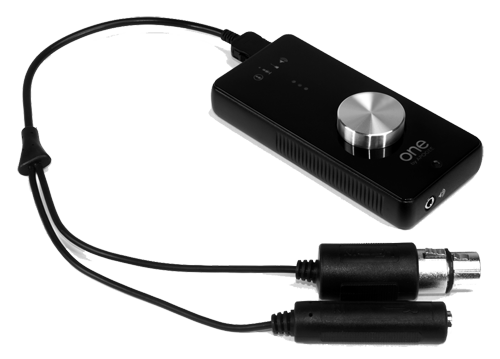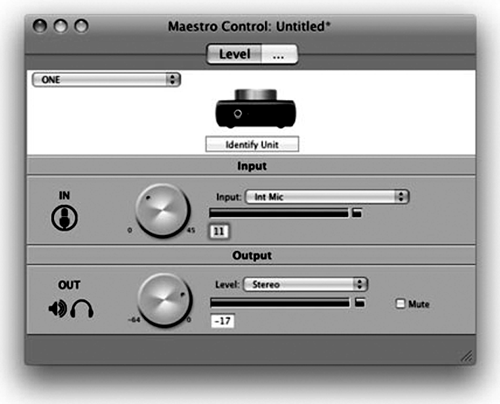by Steve Cunningham
Apogee Electronics is well known among high end recording studios for building accurate multichannel analog-to-digital and digital-to-analog converters, along with digital clocks like Big Ben that are used to eliminate jitter and errors when connecting multiple digital devices.
My own experience has been that Apogee converters are several steps above any others I’ve listened to critically, although they carry a price tag that is commensurate with their quality.
More recently the company has delved into a somewhat more popular price point with their Firewire-based Duet two channel interface at $499. Now they’ve pulled the trigger on what could be seen as the Duet’s younger cousin. The Apogee ONE is a single channel USB audio interface with a built in microphone, and a US list price of $249. The ONE looks as if it could serve nicely in a remote voiceover kit or even in a VO talent’s studio. Apogee’s reputation for sound quality is near legendary, and the ONE offers 24-bit audio at sample rates of up to 48kHz. It even features a mic preamp for external mics, with 48V phantom power to go along with it. USB provides both power and communications for the ONE, which features a mono input and stereo outputs. Let’s take a look.

FIRST THINGS FIRST
The first issue that must be mentioned is that the Apogee ONE, like the Duet and several other Apogee converters, is designed for use with Macintosh computers only. Perhaps the company is protecting a favorite son relationship with Apple, but even if they are not it’s puzzling that they’ve chosen to exclude the larger portion of the market in desktop audio, particularly with a product at this price point. On the other hand, if you like it then your decision to put a Mac in your VO studio may be easier. Or not. At least the ONE still supports the older G5 processors, which are rapidly becoming unsupported by software developers, in addition to the Intel chips. But the Apogee product is, at this time anyway, Mac-only.
In any case, the ONE certainly looks like it could have been designed by Steve Jobs’ industrial design group. The little box is very attractive in gloss black plastic with a large-ish silver multifunction encoder-and-push-switch (we’ll just call it a knob, okay?). Ribbed side panels provided enough grip to keep me from dropping the thing, which is slightly larger than an iPod at 2.25” wide x 4.75” tall x 1” high. Backlit icons on the top panel display the current I/O state of the device, and a three LED column above the knob serves as input and output meters. The built-in mic is visible as the round indented bit just below the knob. It’s all quite stylish thanks in part to the encoder -- I mean the knob -- being the only input device available on the thing. Nearly all of the setup options must be entered in the included Maestro Mixer and Control software. More on that later.
The gozintas and gozoutas are on the end blocks, and nearby icons identify their life’s purpose. The stereo output, which can drive either headphones or powered monitors, is delivered on a 3.5 mm stereo mini-jack connector located at the bottom panel of the unit. The input assembly is on the top panel, and consists of a proprietary connector for a breakout cable, which in turn provides both XLR and quarter phone jacks. The cable is not overly long and has a locking connector, so it shouldn’t get detached in the middle of a session. Next to that is what I believe is technically a micro-B USB connector, similar to those found on digital cameras. That one obviously connects the ONE to a computer, which in turn lights up the speaker icon on the top panel.
Like many other USB interfaces, Apogee recommends that the ONE specifically not be connected to the computer through a USB hub. Rather, it should be connected directly to one of the computer’s USB ports. This could present a problem should you intend to use the internal microphone while locating your computer far enough away to avoid picking up fan noise. In that instance you will want a longer USB cable than the one provided, so you’ll need to procure either a longer cable with a micro-B on one end and a regular male A-type on the other, or an extension cable with a male A-type on one end and a female A-type on the other. Apogee will sell you one for twenty bucks, but a judicious bit of online shopping should allow you to do better.
From a specification standpoint, the external microphone input claims a gain range from +10 to 63 dB with a maximum level of +14 dBU, while the quarter inch input and internal microphone preamp can each deliver +45 dB of gain, with the quarter inch maxing out at a level of +11dBu. There’s also a switchable 48V phantom power option for condenser mics. In addition, the aforementioned stereo output provides a maximum level of +12 dBu. As mentioned, supported sample rates are 44.1 and 48 kHz, and word length is 24 bits only. Altogether not bad for a USB- powered device.

A BIT OF SOFTWARE
By the time you’ve got the breakout cable, USB, and headphones connected, the ONE will have become somewhat less stylish, as well as less mobile. Moreover, a glance at one of the pictures will reveal a potential issue with setting up the ONE in such a way as to make the internal mic accessible. If you want to use the mic, then you’ll definitely want to budget another twenty bucks for the mic mount, a clip that will allow the ONE to be mounted on a mic stand and angled appropriately for internal mic use, and for including a pop filter in the rig.
It’s too bad that the ONE’s connectors aren’t all mounted either on the top panel, or all on the bottom panel -- preferably on top panel for desktop use -- to make cable management a little cleaner. On the other hand, if one were simply going to use the ONE as a mic-and-interface combo when traveling, it probably wouldn’t make much difference since the breakout would be superfluous in that situation anyway.
Having connected the ONE to a MacBook Pro laptop, I installed the Maestro software package from the included disc. After the required reboot, I launched it and was presented with the Maestro Control and Maestro Mixer pages. Given that the unit is a mono-in, stereo-out device the pages are simple enough. The Mixer displays a meter, fader and mute/solo buttons for the single input and “From Software” channels, with a slightly larger meter displaying the overall “To Hardware” output level. The Control page has gain controls for both the input and output levels, and the input is selectable between Internal Mic, External Mic, External 48V Mic and Inst, which of course selects the quarter phone input. Setting the input lights the appropriate icon on the top of the ONE as expected. In addition, engaging phantom power setting in software lights the red LED directly above the external mic indicator.
The knob on the top panel controls the level of either the currently selected input, or the output. Pressing the knob briefly will cycle through the various input and output options, allowing you to change gain settings. A display, similar to the built-in Mac OS volume display, appears on the computer screen when you make changes, and shows which input or output is being changed. If the knob is pressed and held for one second, then the output it muted.
As soon as input signal is applied, the three-LED column for level does its thing. Note that Apogee is quick to explain that the meters on the top panel, and in the software mixer, display the signal at different points in the signal path, and may not match. Here’s the difference: When the knob is set to an input, the LEDs show the signal level after gain but before the A/D conversion. The software meters show the level after the A/D conversion. When the knob is set to the output, the top panel meter displays the analog signal after output level gain has been applied. This means that as your monitoring level is decreased, the level displayed on the top panel meters decreases as well. The output meters in the software display the signal before the conversion from digital back to analog. The top panel meter’s red Over LED only lights when the input level is selected, and won’t display overs at the output. Digital overs are only displayed in the software meters, so it’s best to check them during monitoring and adjust your workstation’s output level accordingly.
Got all that? It’s actually a lot simpler in use than in the above description. In fact, once you have the levels set up in the software, using the ONE is a simple matter. So how does it sound?
GOING FOR THE ONE
In a word, fabulous. I compared the ONE with both an Mbox 2 and with an M-Audio Firewire 1814 (granted, both are older units). The overall audio quality of the ONE is surprisingly good, especially at its price point. Using an RE-20 and Harlan Hogan’s MXL mics both yielded a sound that was noticeably more open than with either of the other interfaces.
Even more surprising was the performance of the built-in electret condenser microphone. As you might expect, no one will ever mistake it for a Neumann, but it’s darned good... easily good enough for a remote VO recording session. Crisp and clean, with enough low end response to get the job done. I didn’t work it closely -- the design of the ONE really precludes that -- but at eight inches or so away I got what I consider to be a very acceptable voiceover track, with no noise.
According to Apogee, the ONE works well with any Core Audio-compliant software package, and I tried it with three of them -- Audiofile Engineering’s Wave Editor, Amadeus, and TwistedWave. All worked as expected, and delivered no surprises.
The only downside I encountered was the manual. Apogee includes a QuickStart guide in the box, but the more detailed User’s Guide is only available online at the company website, and only as one page per webpage with no navigation. After you’ve read a page, you have to hit the back button to get to the table of contents so you can read the next page... a complete pain. There’s also no downloadable version of the entire manual, but they do offer a downloadable PDF of each page, which can be found on -- you guessed it -- each online web page. An unfortunate situation, I’m afraid. Thank goodness the thing sounds good as good as it does.
The only other nit I’ll pick is with Apogee’s pricing. I don’t know whether it’s the cache of the Apogee name or distribution rules or what, but Apogee products tend to not be discounted by retailers. Come to think of it, it can’t have much to do with distribution, since the best price I could find was via Amazon.com, which featured the ONE at a hefty two percent discount through one of their partner retailers.
If it’s available through Amazon, then it’s available all over the place, right? In any case, expect to pay full clip for the ONE.
But for a mobile rig that rocks a MacBook Pro, it’s worth it. The ONE lives up to Apogee’s reputation; that much is certain. Steve sez check it out. On a Mac, unfortunately, but check it out anyway.
The Apogee ONE is shipping now at a suggested US retail of $249. For more information worldwide, visit www.apogeedigital.com.
